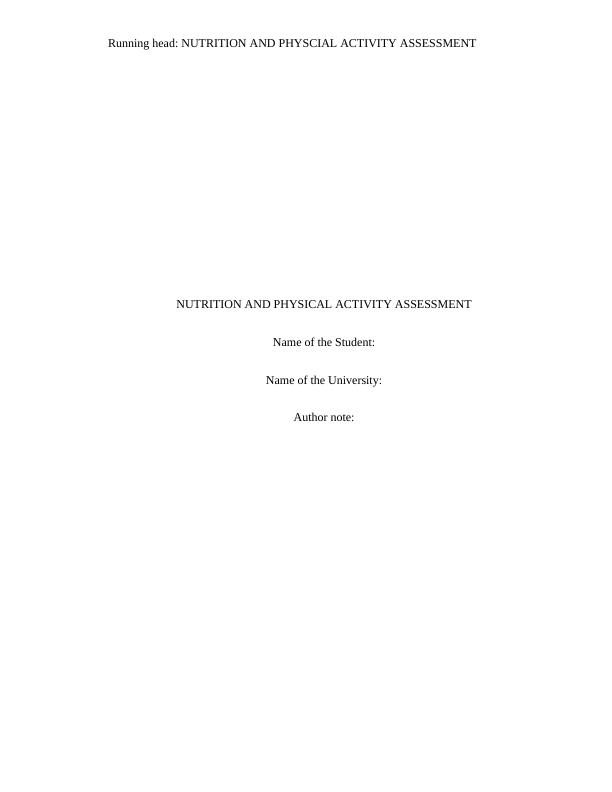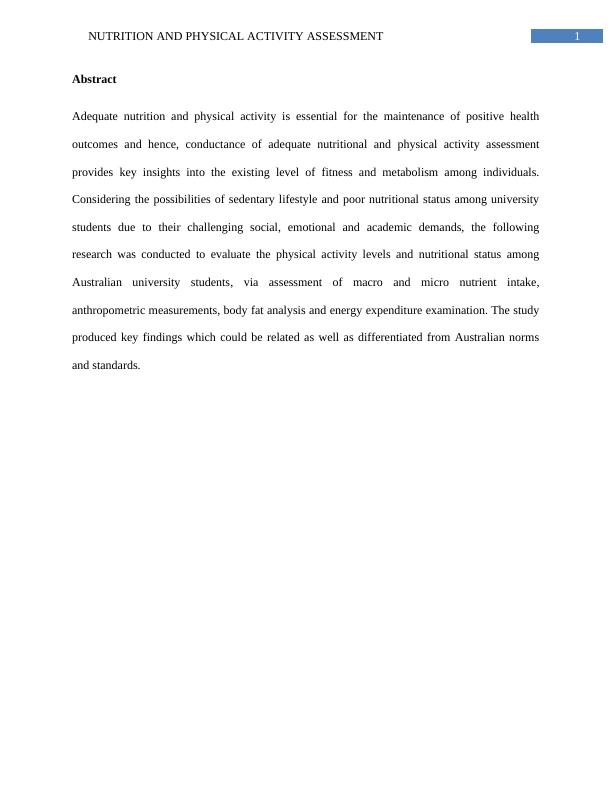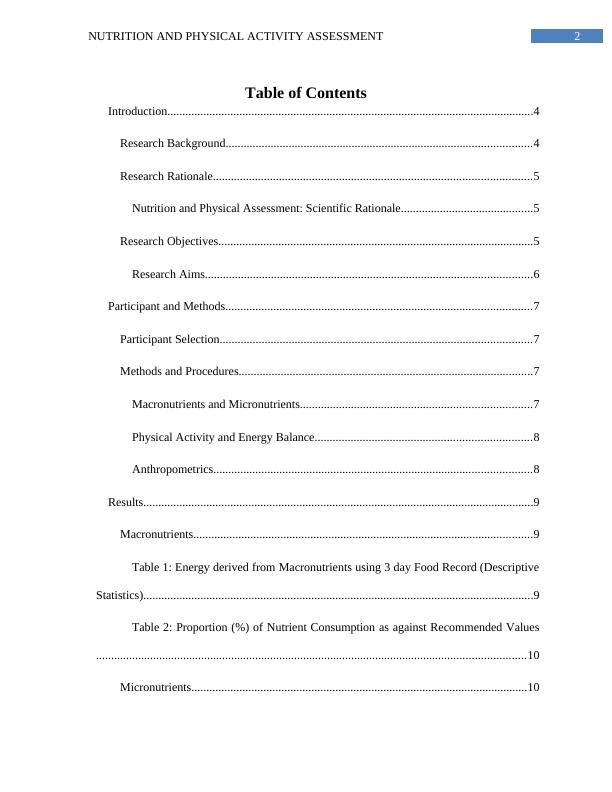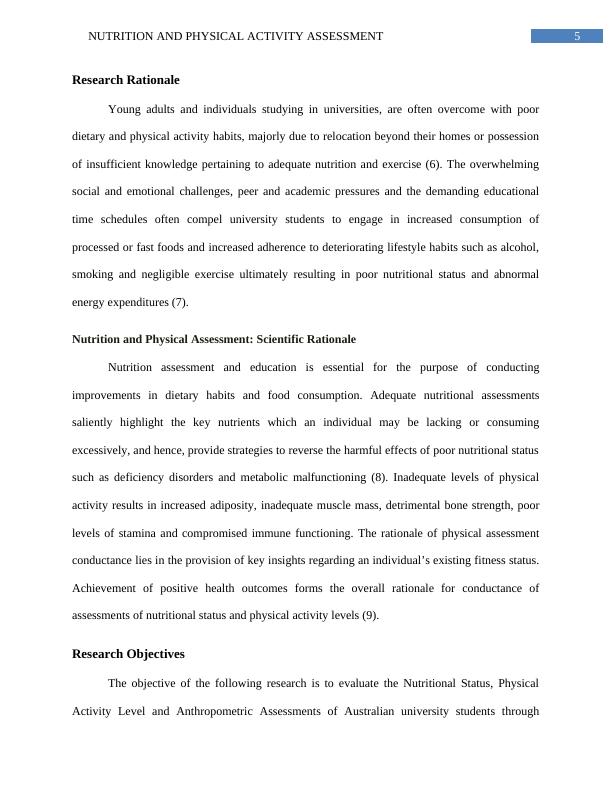Nutrition and Physical Activity Assessment
Added on 2023-04-21
24 Pages5959 Words424 Views
Running head: NUTRITION AND PHYSCIAL ACTIVITY ASSESSMENT
NUTRITION AND PHYSICAL ACTIVITY ASSESSMENT
Name of the Student:
Name of the University:
Author note:
NUTRITION AND PHYSICAL ACTIVITY ASSESSMENT
Name of the Student:
Name of the University:
Author note:

1NUTRITION AND PHYSICAL ACTIVITY ASSESSMENT
Abstract
Adequate nutrition and physical activity is essential for the maintenance of positive health
outcomes and hence, conductance of adequate nutritional and physical activity assessment
provides key insights into the existing level of fitness and metabolism among individuals.
Considering the possibilities of sedentary lifestyle and poor nutritional status among university
students due to their challenging social, emotional and academic demands, the following
research was conducted to evaluate the physical activity levels and nutritional status among
Australian university students, via assessment of macro and micro nutrient intake,
anthropometric measurements, body fat analysis and energy expenditure examination. The study
produced key findings which could be related as well as differentiated from Australian norms
and standards.
Abstract
Adequate nutrition and physical activity is essential for the maintenance of positive health
outcomes and hence, conductance of adequate nutritional and physical activity assessment
provides key insights into the existing level of fitness and metabolism among individuals.
Considering the possibilities of sedentary lifestyle and poor nutritional status among university
students due to their challenging social, emotional and academic demands, the following
research was conducted to evaluate the physical activity levels and nutritional status among
Australian university students, via assessment of macro and micro nutrient intake,
anthropometric measurements, body fat analysis and energy expenditure examination. The study
produced key findings which could be related as well as differentiated from Australian norms
and standards.

2NUTRITION AND PHYSICAL ACTIVITY ASSESSMENT
Table of Contents
Introduction..........................................................................................................................4
Research Background......................................................................................................4
Research Rationale..........................................................................................................5
Nutrition and Physical Assessment: Scientific Rationale............................................5
Research Objectives.........................................................................................................5
Research Aims.............................................................................................................6
Participant and Methods......................................................................................................7
Participant Selection........................................................................................................7
Methods and Procedures..................................................................................................7
Macronutrients and Micronutrients.............................................................................7
Physical Activity and Energy Balance........................................................................8
Anthropometrics..........................................................................................................8
Results..................................................................................................................................9
Macronutrients.................................................................................................................9
Table 1: Energy derived from Macronutrients using 3 day Food Record (Descriptive
Statistics)..................................................................................................................................9
Table 2: Proportion (%) of Nutrient Consumption as against Recommended Values
...............................................................................................................................................10
Micronutrients................................................................................................................10
Table of Contents
Introduction..........................................................................................................................4
Research Background......................................................................................................4
Research Rationale..........................................................................................................5
Nutrition and Physical Assessment: Scientific Rationale............................................5
Research Objectives.........................................................................................................5
Research Aims.............................................................................................................6
Participant and Methods......................................................................................................7
Participant Selection........................................................................................................7
Methods and Procedures..................................................................................................7
Macronutrients and Micronutrients.............................................................................7
Physical Activity and Energy Balance........................................................................8
Anthropometrics..........................................................................................................8
Results..................................................................................................................................9
Macronutrients.................................................................................................................9
Table 1: Energy derived from Macronutrients using 3 day Food Record (Descriptive
Statistics)..................................................................................................................................9
Table 2: Proportion (%) of Nutrient Consumption as against Recommended Values
...............................................................................................................................................10
Micronutrients................................................................................................................10

3NUTRITION AND PHYSICAL ACTIVITY ASSESSMENT
Table 3: Group Micronutrient Intake (Descriptive Statistics)...................................11
Table 4: Proportion (%) at risk of Inadequate Micronutrient Intake (3 Day Food
Record)..................................................................................................................................11
Physical Activity and Energy Balance..........................................................................11
Table 5: Group Results (Descriptive Statistics) for Energy Expenditure and Energy
Intake.....................................................................................................................................12
Anthropometrics............................................................................................................12
Table 6: Group Results (Descriptive Statistics) of Anthropometric Measurement...12
Table 7: Participant Proportion (%) in each Waist Circumference (WC) Category. 13
Table 8: Participant Proportion (%) in each Body Mass Index (BMI) Category......13
Discussion..........................................................................................................................13
Major Findings...............................................................................................................13
Limitations.................................................................................................................14
Comparison with Australian Recommendations and Australian Population Trends....14
Similarities and Differences..........................................................................................16
Estimation of Calcium Intake....................................................................................16
Estimation of Energy Expenditure.............................................................................17
Estimation of Body Fat Percentage...........................................................................17
Conclusion.........................................................................................................................17
References..........................................................................................................................19
Table 3: Group Micronutrient Intake (Descriptive Statistics)...................................11
Table 4: Proportion (%) at risk of Inadequate Micronutrient Intake (3 Day Food
Record)..................................................................................................................................11
Physical Activity and Energy Balance..........................................................................11
Table 5: Group Results (Descriptive Statistics) for Energy Expenditure and Energy
Intake.....................................................................................................................................12
Anthropometrics............................................................................................................12
Table 6: Group Results (Descriptive Statistics) of Anthropometric Measurement...12
Table 7: Participant Proportion (%) in each Waist Circumference (WC) Category. 13
Table 8: Participant Proportion (%) in each Body Mass Index (BMI) Category......13
Discussion..........................................................................................................................13
Major Findings...............................................................................................................13
Limitations.................................................................................................................14
Comparison with Australian Recommendations and Australian Population Trends....14
Similarities and Differences..........................................................................................16
Estimation of Calcium Intake....................................................................................16
Estimation of Energy Expenditure.............................................................................17
Estimation of Body Fat Percentage...........................................................................17
Conclusion.........................................................................................................................17
References..........................................................................................................................19

4NUTRITION AND PHYSICAL ACTIVITY ASSESSMENT
Introduction
The challenging stage of late adolescence and young adulthood, coupledwith academic,
emotional and social pressures often result in detrimental health conditions in university
students, such as micronutrient deficiencies, poor stamina and fitness levels, excessive or
inadequate energy expenditure and increased adiposity (1). Prior to enhancing existing
nutritional and physical activity awareness among university students, the conductance of
nutritional, physical activity and anthropometric assessments is of utmost importance (2).
Research Background
In accordance to the data presented by the Australian Health Survey in the years 2011 to
2012, nearly 12 million or 70% of adults were found to adhere to negligible levels of physical
activity or sedentary lifestyles. Additionally, the survey also recorded a merely 53% of young
adults, within 18 to 24 years, participating in adequate levels of physical activity (3).As per the
most recent findings by the Australian Institute of Health and Welfare, nearly all Australians
over the age of 19, and almost 4 out of 5 Australians in the age group of 19 to 50 years, engaged
in insufficient consumption of fruits and vegetables, with deficiencies of iron and calcium noted
among women and girls (4).Adherence to adequate nutritional and physically activity levels is
essential for basic functioning. Individuals must engage in assessments of the same to obtain key
insights of their existing nutritional status and possible susceptibilities to detrimental metabolic
disorders (5).
Introduction
The challenging stage of late adolescence and young adulthood, coupledwith academic,
emotional and social pressures often result in detrimental health conditions in university
students, such as micronutrient deficiencies, poor stamina and fitness levels, excessive or
inadequate energy expenditure and increased adiposity (1). Prior to enhancing existing
nutritional and physical activity awareness among university students, the conductance of
nutritional, physical activity and anthropometric assessments is of utmost importance (2).
Research Background
In accordance to the data presented by the Australian Health Survey in the years 2011 to
2012, nearly 12 million or 70% of adults were found to adhere to negligible levels of physical
activity or sedentary lifestyles. Additionally, the survey also recorded a merely 53% of young
adults, within 18 to 24 years, participating in adequate levels of physical activity (3).As per the
most recent findings by the Australian Institute of Health and Welfare, nearly all Australians
over the age of 19, and almost 4 out of 5 Australians in the age group of 19 to 50 years, engaged
in insufficient consumption of fruits and vegetables, with deficiencies of iron and calcium noted
among women and girls (4).Adherence to adequate nutritional and physically activity levels is
essential for basic functioning. Individuals must engage in assessments of the same to obtain key
insights of their existing nutritional status and possible susceptibilities to detrimental metabolic
disorders (5).

5NUTRITION AND PHYSICAL ACTIVITY ASSESSMENT
Research Rationale
Young adults and individuals studying in universities, are often overcome with poor
dietary and physical activity habits, majorly due to relocation beyond their homes or possession
of insufficient knowledge pertaining to adequate nutrition and exercise (6). The overwhelming
social and emotional challenges, peer and academic pressures and the demanding educational
time schedules often compel university students to engage in increased consumption of
processed or fast foods and increased adherence to deteriorating lifestyle habits such as alcohol,
smoking and negligible exercise ultimately resulting in poor nutritional status and abnormal
energy expenditures (7).
Nutrition and Physical Assessment: Scientific Rationale
Nutrition assessment and education is essential for the purpose of conducting
improvements in dietary habits and food consumption. Adequate nutritional assessments
saliently highlight the key nutrients which an individual may be lacking or consuming
excessively, and hence, provide strategies to reverse the harmful effects of poor nutritional status
such as deficiency disorders and metabolic malfunctioning (8). Inadequate levels of physical
activity results in increased adiposity, inadequate muscle mass, detrimental bone strength, poor
levels of stamina and compromised immune functioning. The rationale of physical assessment
conductance lies in the provision of key insights regarding an individual’s existing fitness status.
Achievement of positive health outcomes forms the overall rationale for conductance of
assessments of nutritional status and physical activity levels (9).
Research Objectives
The objective of the following research is to evaluate the Nutritional Status, Physical
Activity Level and Anthropometric Assessments of Australian university students through
Research Rationale
Young adults and individuals studying in universities, are often overcome with poor
dietary and physical activity habits, majorly due to relocation beyond their homes or possession
of insufficient knowledge pertaining to adequate nutrition and exercise (6). The overwhelming
social and emotional challenges, peer and academic pressures and the demanding educational
time schedules often compel university students to engage in increased consumption of
processed or fast foods and increased adherence to deteriorating lifestyle habits such as alcohol,
smoking and negligible exercise ultimately resulting in poor nutritional status and abnormal
energy expenditures (7).
Nutrition and Physical Assessment: Scientific Rationale
Nutrition assessment and education is essential for the purpose of conducting
improvements in dietary habits and food consumption. Adequate nutritional assessments
saliently highlight the key nutrients which an individual may be lacking or consuming
excessively, and hence, provide strategies to reverse the harmful effects of poor nutritional status
such as deficiency disorders and metabolic malfunctioning (8). Inadequate levels of physical
activity results in increased adiposity, inadequate muscle mass, detrimental bone strength, poor
levels of stamina and compromised immune functioning. The rationale of physical assessment
conductance lies in the provision of key insights regarding an individual’s existing fitness status.
Achievement of positive health outcomes forms the overall rationale for conductance of
assessments of nutritional status and physical activity levels (9).
Research Objectives
The objective of the following research is to evaluate the Nutritional Status, Physical
Activity Level and Anthropometric Assessments of Australian university students through

End of preview
Want to access all the pages? Upload your documents or become a member.
Related Documents
Assessment of Physical Activity and Nutritionlg...
|23
|6138
|353
Assessment of Nutrition, Physical Activity, and Anthropometric Measuring Techniqueslg...
|31
|8965
|204
Healthcare Study: Nutrient Intake and Physical Activity Assessmentlg...
|22
|4843
|354
Diet Analysis and Discussion on Human Nutrition and Foodlg...
|5
|2001
|63
Nutritional Assessment Case studylg...
|6
|1869
|54
Dietary Analysis for a Pro Footballer: Sports Nutrition Projectlg...
|15
|2952
|374